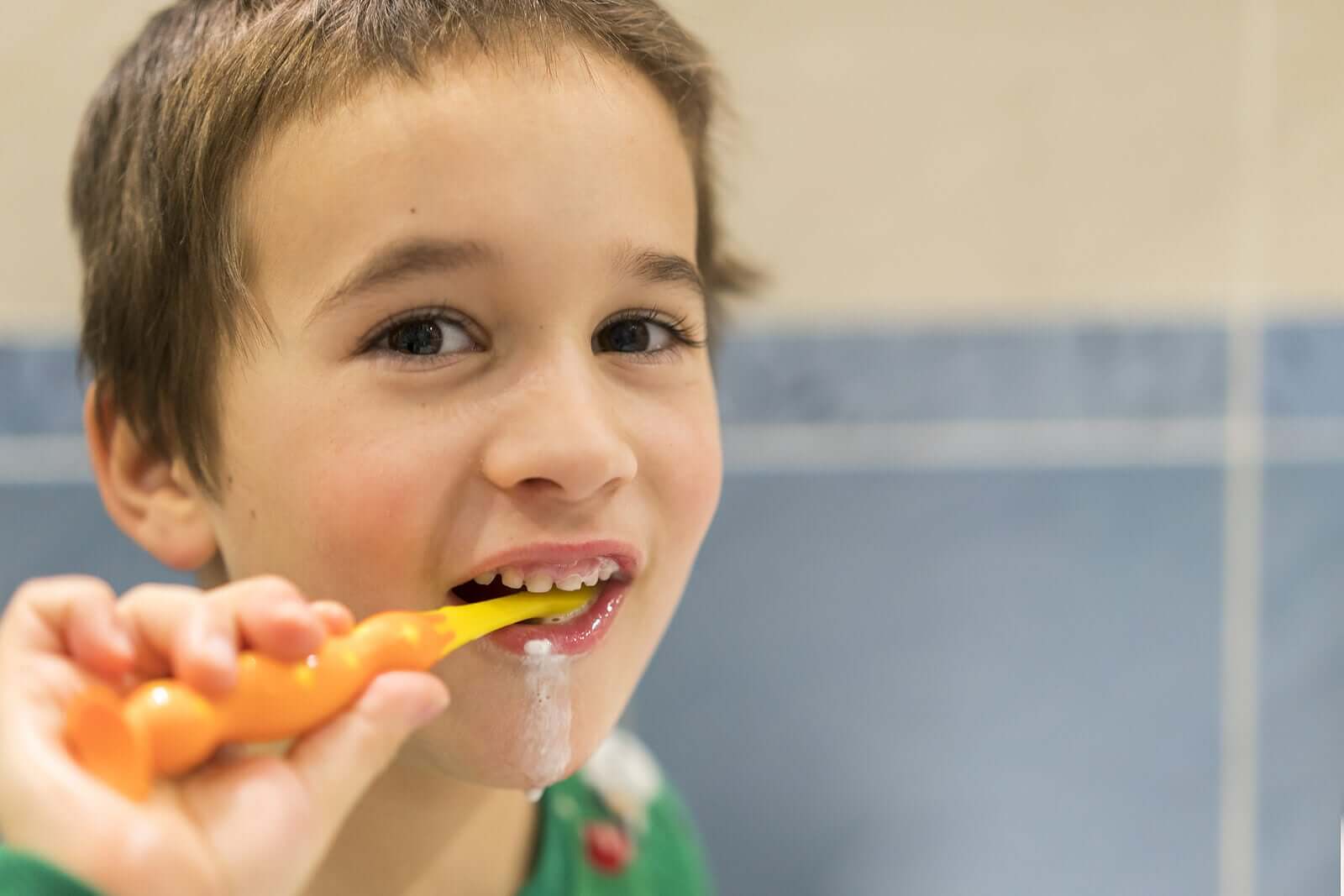Is Fluoride Good or Bad for Kids?

It’s common for parents to wonder whether using fluoride is safe for their children. It’s logical to wonder whether there are risks, what the recommended concentration is, and how it should be administered to children.
Confusion and doubts can arise because, some years ago, the American Dental Association (ADA) recommended not using fluoride before a child was 2 years of age or until they could spit.
However, nowadays, and ever since 2014, the same association has changed its mind. After extensive reviews and research, it now suggests that we can start to use it in low amounts as soon as teeth appear.
In the following article, we’ll tell you what fluoride is and why it’s beneficial in preventing the appearance of cavities. We’ll also explain its risks and the best way to use it in children.
What is fluoride?
Fluoride is a naturally occurring chemical element. We can find it in soil, air, and water. Its concentration in water depends on its origin.
In addition, we can also find it in small amounts in some foods such as blue fish, vegetables (cabbage and spinach), fruits (grapes), cereals (wheat and rice), and in black tea.

This mineral is very useful in dental care due to its effectiveness in preventing cavities. When combined with tooth enamel, the hydroxyapatite that makes up the teeth changes into fluorapatite. This material is much more resistant to the action of bacterial acids.
Why should children use fluoride?
Fluoride plays an important role in strengthening children’s teeth and bones. As already mentioned, it improves the quality and resistance of the enamel against the action of acids produced by bacteria in the mouth. In this way, it’s able to prevent the onset of tooth decay and even treat the first signs of this disease.
Dental caries is one of the most frequent diseases in childhood. It’s a multifactorial condition in which the bacteria in the mouth – combined with other nutritional and social factors and a person’s individual characteristics – produce acids that remove minerals from the teeth.
The elimination of these bacteria in a mechanical way, through tooth brushing, is fundamental in order to prevent this disease. Experts have proven that the use of fluorides in the mouth reduces the risk of caries.
On the one hand, its action consists of inhibiting or delaying the demineralization of the enamel. On the other hand, it favors remineralization when crystals have already been lost. In addition, its presence in the mouth reduces the proliferation of bacteria.
How to use fluoride in children?
You can introduce fluoride in two main ways. One is through the systemic route, which is through the ingestion of a product containing the mineral. The other is the topical route, where you apply it directly in the mouth.
The systemic route
Via this route, the fluoride enters the organism through food intake or by drinking water. It’s absorbed by the digestive mucosa, passing into the bloodstream, and is then distributed to the tissues, being deposited mainly in bones and teeth.
The most common way of incorporating fluoride by this route is through drinking water. You’ll need to ensure that the water has an optimal and safe concentration (0.7 to 1.2 milligrams per liter). This is because higher levels can be toxic, and lower levels may require the use of supplements in patients at high risk of tooth decay.
In general, public tap water contains optimal levels of fluoride and is safe for the general population.
The systemic action of fluoride in children occurs in the pre-eruptive period, i.e. when teeth are still forming in the bones. Its availability during tooth formation is beneficial, but its effect on caries prevention is less effective than through the topical route.
The topical route
In this case, fluoride is applied directly onto the erupted teeth. The most effective way is to do this when the tooth has just erupted, because it’s more porous at this stage, and can better absorb the mineral. We’re talking here about the use of toothpastes, mouthwashes, gels, and varnishes used by dentists.

Fluoride toothpaste is what every parent uses at home with their children. The important thing is to make sure the fluoride concentration is appropriate for the child’s age.
The ADA recommends that the concentration of fluoride in toothpaste for children from 0 to 3 years of age should be 500 parts per million (ppm). From 3 to 6 years of age, it should be 1000 ppm, and for children over 6 years of age 1500-2000 ppm.
As the mineral content is higher in the latter group, you should be careful how much toothpaste you put on their brush, and try to prevent them from swallowing it.
As we’ve already mentioned, experts now consider it appropriate to begin dental hygiene with fluoride toothpaste as soon as the teeth erupt. Place only a spot of paste on the toothbrush (smaller than a grain of rice) and clean with paste no more than twice a day.
Tilting the baby’s head slightly downwards helps the toothpaste and saliva to fall and the baby doesn’t swallow so much of the product.
From the age of 3, the amount should be the size of a pea and children should be encouraged to spit out the paste and not swallow it. This is the age when they begin to learn to spit. The adults should do the brushing until the child is 6 or 7 years of age and then, after that, they should supervise them.
Other fluoride products for children
Regarding fluoride rinses, the dentist will be the one who needs to prescribe them, according to the individual risk of tooth decay in the child. In general, they won’t recommend them before the child is six, as they’ll need to know how to spit it out correctly.
The gels and varnishes mentioned above are for professional use, in the dental surgery. The dentist will apply them according to the needs of each child. It’s common to perform fluoride applications on recently erupted permanent teeth.
Risks of fluoride use in children
The regular use of fluoride doesn’t pose a risk to human health. Its most common associated hazard is dental fluorosis, although this isn’t very common.
This condition is caused by the excessive consumption of fluoride during the period of tooth formation. From the age of 8, after the teeth have all appeared in the child’s mouth, the risk disappears.
Fluorosis is associated with the use of water with a high fluoride content in a particular area – water that hasn’t been correctly analyzed. There isn’t a major risk from using dental products topically, except in cases of accidental excessive ingestion.
Fluorosis appears as white, yellow, or brown spots on the tooth surface, depending on how affected the teeth are. It doesn’t usually affect tooth function or cause pain; there’s only a change in appearance.
To reduce the risk of dental fluorosis, it’s important to check the fluoride levels in drinking water. It’s also important to use a toothpaste with the right concentration of the mineral for the child’s age, and to only use the recommended amount.
Teaching the child to spit and not swallow the toothpaste is also useful. Toothbrushing up to 6 years of age should be carried out by an adult and then, after that, should be supervised. It’s a good idea to keep the product out of children’s reach.
If the child swallows a small amount of toothpaste, it isn’t a problem. If it’s a relatively large amount and the child swallows or eats the toothpaste for whatever reason, then they may get an upset stomach.
In these cases, you should consult your pediatrician or call the emergency services to be sure. Experts recommend giving them milk as calcium binds to fluoride in the stomach.

The benefits of fluoride outweigh the risks
The use of fluoride in children is of great benefit in preventing the appearance of cavities, a very common ailment in young children. The key is to achieve a balance between giving enough fluoride to avoid dental problems and not giving it in excess and causing other problems. Fluoride toothpaste used correctly is safe.
When in doubt about the use of fluoride with children, it’s always best to consult your dentist. They’ll evaluate the risk of cavities, and will be able to give the appropriate advice for each particular case.
If you prefer to use toothpastes without fluoride, then you need to know that this will only help to clean the teeth and leave a pleasant sensation and taste in the mouth. It won’t protect against cavities in the same way that fluoride products do.
Regardless of the decision made, it’s always important to brush your child’s teeth to ensure that plaque is removed. Another important thing is to consult your dentist frequently. Visits every six months allow for early detection of any problems and early action.
It’s common for parents to wonder whether using fluoride is safe for their children. It’s logical to wonder whether there are risks, what the recommended concentration is, and how it should be administered to children.
Confusion and doubts can arise because, some years ago, the American Dental Association (ADA) recommended not using fluoride before a child was 2 years of age or until they could spit.
However, nowadays, and ever since 2014, the same association has changed its mind. After extensive reviews and research, it now suggests that we can start to use it in low amounts as soon as teeth appear.
In the following article, we’ll tell you what fluoride is and why it’s beneficial in preventing the appearance of cavities. We’ll also explain its risks and the best way to use it in children.
What is fluoride?
Fluoride is a naturally occurring chemical element. We can find it in soil, air, and water. Its concentration in water depends on its origin.
In addition, we can also find it in small amounts in some foods such as blue fish, vegetables (cabbage and spinach), fruits (grapes), cereals (wheat and rice), and in black tea.

This mineral is very useful in dental care due to its effectiveness in preventing cavities. When combined with tooth enamel, the hydroxyapatite that makes up the teeth changes into fluorapatite. This material is much more resistant to the action of bacterial acids.
Why should children use fluoride?
Fluoride plays an important role in strengthening children’s teeth and bones. As already mentioned, it improves the quality and resistance of the enamel against the action of acids produced by bacteria in the mouth. In this way, it’s able to prevent the onset of tooth decay and even treat the first signs of this disease.
Dental caries is one of the most frequent diseases in childhood. It’s a multifactorial condition in which the bacteria in the mouth – combined with other nutritional and social factors and a person’s individual characteristics – produce acids that remove minerals from the teeth.
The elimination of these bacteria in a mechanical way, through tooth brushing, is fundamental in order to prevent this disease. Experts have proven that the use of fluorides in the mouth reduces the risk of caries.
On the one hand, its action consists of inhibiting or delaying the demineralization of the enamel. On the other hand, it favors remineralization when crystals have already been lost. In addition, its presence in the mouth reduces the proliferation of bacteria.
How to use fluoride in children?
You can introduce fluoride in two main ways. One is through the systemic route, which is through the ingestion of a product containing the mineral. The other is the topical route, where you apply it directly in the mouth.
The systemic route
Via this route, the fluoride enters the organism through food intake or by drinking water. It’s absorbed by the digestive mucosa, passing into the bloodstream, and is then distributed to the tissues, being deposited mainly in bones and teeth.
The most common way of incorporating fluoride by this route is through drinking water. You’ll need to ensure that the water has an optimal and safe concentration (0.7 to 1.2 milligrams per liter). This is because higher levels can be toxic, and lower levels may require the use of supplements in patients at high risk of tooth decay.
In general, public tap water contains optimal levels of fluoride and is safe for the general population.
The systemic action of fluoride in children occurs in the pre-eruptive period, i.e. when teeth are still forming in the bones. Its availability during tooth formation is beneficial, but its effect on caries prevention is less effective than through the topical route.
The topical route
In this case, fluoride is applied directly onto the erupted teeth. The most effective way is to do this when the tooth has just erupted, because it’s more porous at this stage, and can better absorb the mineral. We’re talking here about the use of toothpastes, mouthwashes, gels, and varnishes used by dentists.

Fluoride toothpaste is what every parent uses at home with their children. The important thing is to make sure the fluoride concentration is appropriate for the child’s age.
The ADA recommends that the concentration of fluoride in toothpaste for children from 0 to 3 years of age should be 500 parts per million (ppm). From 3 to 6 years of age, it should be 1000 ppm, and for children over 6 years of age 1500-2000 ppm.
As the mineral content is higher in the latter group, you should be careful how much toothpaste you put on their brush, and try to prevent them from swallowing it.
As we’ve already mentioned, experts now consider it appropriate to begin dental hygiene with fluoride toothpaste as soon as the teeth erupt. Place only a spot of paste on the toothbrush (smaller than a grain of rice) and clean with paste no more than twice a day.
Tilting the baby’s head slightly downwards helps the toothpaste and saliva to fall and the baby doesn’t swallow so much of the product.
From the age of 3, the amount should be the size of a pea and children should be encouraged to spit out the paste and not swallow it. This is the age when they begin to learn to spit. The adults should do the brushing until the child is 6 or 7 years of age and then, after that, they should supervise them.
Other fluoride products for children
Regarding fluoride rinses, the dentist will be the one who needs to prescribe them, according to the individual risk of tooth decay in the child. In general, they won’t recommend them before the child is six, as they’ll need to know how to spit it out correctly.
The gels and varnishes mentioned above are for professional use, in the dental surgery. The dentist will apply them according to the needs of each child. It’s common to perform fluoride applications on recently erupted permanent teeth.
Risks of fluoride use in children
The regular use of fluoride doesn’t pose a risk to human health. Its most common associated hazard is dental fluorosis, although this isn’t very common.
This condition is caused by the excessive consumption of fluoride during the period of tooth formation. From the age of 8, after the teeth have all appeared in the child’s mouth, the risk disappears.
Fluorosis is associated with the use of water with a high fluoride content in a particular area – water that hasn’t been correctly analyzed. There isn’t a major risk from using dental products topically, except in cases of accidental excessive ingestion.
Fluorosis appears as white, yellow, or brown spots on the tooth surface, depending on how affected the teeth are. It doesn’t usually affect tooth function or cause pain; there’s only a change in appearance.
To reduce the risk of dental fluorosis, it’s important to check the fluoride levels in drinking water. It’s also important to use a toothpaste with the right concentration of the mineral for the child’s age, and to only use the recommended amount.
Teaching the child to spit and not swallow the toothpaste is also useful. Toothbrushing up to 6 years of age should be carried out by an adult and then, after that, should be supervised. It’s a good idea to keep the product out of children’s reach.
If the child swallows a small amount of toothpaste, it isn’t a problem. If it’s a relatively large amount and the child swallows or eats the toothpaste for whatever reason, then they may get an upset stomach.
In these cases, you should consult your pediatrician or call the emergency services to be sure. Experts recommend giving them milk as calcium binds to fluoride in the stomach.

The benefits of fluoride outweigh the risks
The use of fluoride in children is of great benefit in preventing the appearance of cavities, a very common ailment in young children. The key is to achieve a balance between giving enough fluoride to avoid dental problems and not giving it in excess and causing other problems. Fluoride toothpaste used correctly is safe.
When in doubt about the use of fluoride with children, it’s always best to consult your dentist. They’ll evaluate the risk of cavities, and will be able to give the appropriate advice for each particular case.
If you prefer to use toothpastes without fluoride, then you need to know that this will only help to clean the teeth and leave a pleasant sensation and taste in the mouth. It won’t protect against cavities in the same way that fluoride products do.
Regardless of the decision made, it’s always important to brush your child’s teeth to ensure that plaque is removed. Another important thing is to consult your dentist frequently. Visits every six months allow for early detection of any problems and early action.
All cited sources were thoroughly reviewed by our team to ensure their quality, reliability, currency, and validity. The bibliography of this article was considered reliable and of academic or scientific accuracy.
- Toaza Pacheco, Ana Mariela. Aplicación tópica del flúor en piezas permanentes de pacientes de 10 años de la Unidad Educativa 11 de Noviembre de Riobamba. BS thesis. Universidad de Guayaquil. Facultad Piloto de Odontología, 2019.
- Pacheco, Athina Edurner Fernández, Sandra Daniela Guevara Cabrera, and Clara Luisa del Carmen Henckell Sime. “ANTISÉPTICOS ORALES: CLORHEXIDINA, FLÚOR Y TRICLOSÁN.” Salud & Vida Sipanense 6.2 (2019): 4-14.
- Gutiérrez, Jesús Rivas, and Leticia Huerta Vega. “Fluorosis dental: Metabolismo, distribución y absorción del fluoruro.” Revista de la Asociación dental Mexicana 62.6 (2005): 225-229.
- Arrieta-Vergara, Katherine M., Farith González-Martínez, and Luzmayda Luna-Ricardo. “Exploración del riesgo para fluorosis dental en niños de las clínicas odontológicas universidad de Cartagena.” Revista de salud pública 13 (2011): 672-683.
- Hidalgo-Gato Fuentes, Iliana, et al. “Fluorosis dental: no solo un problema estético.” Revista Cubana de Estomatología 44.4 (2007): 0-0.
- Pahuara Romero, Joel Bryan. “Fluorosis dental y la relación con la concentración de fluor en el agua de consumo en niños de 6 a 12 años de edad en el distrito de San Bartolome, Huarochiri–Lima 2019.” (2020).
- Cabello Marquez, Juan José. “EFICACIA DEL USO TOPICO DE FLUOR PARA LA PREVENCIÓN DE CARIES DENTAL EN NIÑOS DE 6 AÑOS DEL CENTRO POBLADO SANTA ROSA DE SIRABAMBA, HUANUCO 2018.” (2019).
- Joison, Agustín Néstor, and Pablo Ruben Gargantini. “Estudio del pH y niveles de flúor en saliva y placa dental en niños con dentición permanente temporaria y mixta.” (2019).
This text is provided for informational purposes only and does not replace consultation with a professional. If in doubt, consult your specialist.








